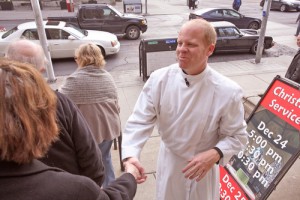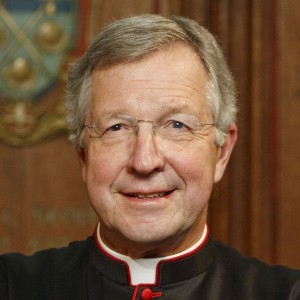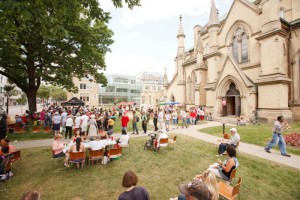By Stuart Mann
The Rev. Canon Andrew Asbil, incumbent of the Church of the Redeemer, Bloor Street, has been named the new rector of St. James Cathedral and dean of Toronto. He will succeed Dean Douglas Stoute, who is stepping down in January.
“To go from the corner of Avenue and Bloor to the corner of King and Church is a real gift,” says Canon Asbil, 54, of his move from Redeemer to the cathedral, both located in downtown Toronto. “It’s a wonderful opportunity for my family and I to stay really connected to the city we love.”

Canon Asbil, who begins his new post on Jan. 25, says he plans to build on the work done by Dean Stoute and the staff at the cathedral, and to explore new avenues for mission and ministry.
“I see opportunities for going deep into the neighbourhood, of making new relationships with George Brown College and Ryerson University and other community gathering places,” he says. “I’d like to expand our liturgical diet so it’s not only steeped in our rich Anglican tradition but branches out in new ways.”
Canon Asbil, who has served at Redeemer for the past 14 years, says ministry in the downtown core presents many challenges and opportunities. “The challenge is that living vertically means that we live with a greater amount of isolation. It feels better because we’ve raised ourselves up but we feel more and more disconnected. I think that’s going to be one of the greatest gifts that downtown core churches offer – how do we break down those walls of isolation that keep people separated? How do we help people understand that they’re actually connected to their neighbours and create common space where faith has a chance to sink in?”
He says the cathedral is ideally situated and suited for that to happen. “Because of its size, the cathedral can be a daunting place for some people to go into, and yet at the same time if offers this atmosphere of mystical space in the heart of a city that’s going 100 miles per hour. We’re able to say, ‘Step inside, come and see. Christ is here for you, we are here for you. Let’s discover together how God is calling us to serve on this corner, in this city, in the world.’”
He says he has been shaped by the ministry at Redeemer and is proud of the church’s commitment to social justice and advocacy. Located at one of the busiest corners in the city, Redeemer’s lunch program feeds about 100 people a day; the program costs more than $130,000, most of which comes from open plate offerings. “Redeemer is a community that says, ‘We’re in.’ It’s the kind of place that wants to experiment and take some really deep risks.”
Canon Asbil graduated from the University of Waterloo with a degree in science and received his Master of Divinity from Huron College in London, Ont. He was ordained in the Diocese of Niagara and served in three parishes there – St. George in Guelph, St. Alban in Acton and the Church of the Incarnation in Oakville – before going to Redeemer in 2001. He has been a member of the Diocese of Toronto’s Diocesan Council and Executive Board. At the national level, he is chair of the Faith, Worship and Ministry Committee and chair of the Liturgy Task Force. He is married to Mary and together they have five children, ages 11 through 18.

Dean Stoute says it has been “wonderful and a great privilege” to have served the cathedral for the past 21 years. “The most important thing that has happened, and that I am very grateful for, is the way the congregation has changed,” he says. “It is very culturally diverse now. What you’re beginning to see on Sunday is a lot like Toronto itself.”
This has happened because the cathedral has been intentional about including newcomers in all aspects of its liturgical life, he says. “It’s important because the cathedral is a living entity in an ever-changing city,” he says. “We are reaching a broad spectrum of people, not just one small enclave.”
Under Dean Stoute’s leadership, the cathedral’s staff has grown significantly, mainly due to the activity at the Cathedral Centre. There are about 48 full- and part-time staff members, including three full-time clergy and four part-time priests who assist in the pastoral and liturgical life of the cathedral.
He says Canon Asbil can expect “a unified, diverse community who will be very supportive.” Of his own plans, he says he will continue serving as a priest in the diocese, but not in an executive role. “I’ve been here for 21 years, and as much as I love it and hate the idea of leaving, I think it’s right for the cathedral. It’s good to leave before the lights are turned out,” he says with a smile.
Busy Cathedral Centre brings together diverse groups
Perhaps nothing quite so neatly illustrates the size and complexity of St. James Cathedral as a calendar on the wall of a small room on the second story of its glass-and-brick Cathedral Centre.
The calendar occupies the entire wall – about 10 feet across – and is filled with a blizzard of coloured dots, indicating some 800 events that are planned throughout the year. The office has a staff of four, just to manage it all.
Indeed, a tour of the cathedral’s office and meeting space on a weekday morning provides a glimpse of church life that is rarely seen – large rooms packed with people, staff indistinguishable from visitors, and the hum of activity and purpose everywhere. “We’re really a community hub,” says Dean Douglas Stoute.

Located at the corner of King and Church streets in downtown Toronto, the cathedral is open seven days a week and provides at least four worship services a day, beginning with a Eucharist at 7:30 a.m. This past summer, about 400 people a day visited the historic Gothic building.
The cathedral figures prominently in the city’s cultural landscape. It provided important outreach during the Occupy movement, supplying water and electricity to protestors camped out next door in St. James Park. It was the site of the Hon. Jim Flaherty’s state funeral in 2014 and, in previous years, welcomed the Queen on two separate occasions.
Much of the activity takes place in the new Cathedral Centre, an $18 million renovation and expansion of the former parish house. The building has won international praise and received several awards. Modern and light-filled throughout, it acts as a conduit for the neighbourhood, bringing together a variety of groups and interests from the business, government and non-profit worlds.
“When the city wants to have meetings and consult with the neighbourhood, they come here,” says Dean Stoute. The centre hosted mayoral debates in the last municipal election and a seminar on the plight of Christians in the Middle East, chaired by the CBC’s Mark Kelly. It regularly hosts forums on social, political and educational matters.
Rental income from the meetings and events helps to fund the cathedral’s outreach, especially its weekly drop-in, which takes place on two levels of the Cathedral Centre. Among the services offered are haircuts to men and women, a foot-care clinic, pastoral counselling and referrals, and a nutritious lunch. The drop-in helps hundreds of people, every week of the year.
Business groups that rent space in the centre often see the drop-in and are moved to assist. Catering companies have provided chefs to prepare meals, food companies send products and a local restaurant hosts an annual elegant holiday dinner in December for the drop-in’s guests.
Leaders from around the world have come to the cathedral to tour the facilities and learn how they can emulate it. Trinity, Wall Street, an Episcopal church in New York, filmed a documentary about the cathedral’s success.
In addition to the activity at King and Church streets, the cathedral owns and operates St. James the Less, a large and historic cemetery and crematorium at Parliament and Bloor streets. The rector of the cathedral is also the priest-in-charge of St. Bartholomew in nearby Regent Park, with the Rev. Walter Hannam serving as St. Bartholomew’s vicar.